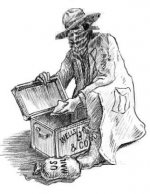Tom_in_CA
Gold Member
- Mar 23, 2007
- 13,804
- 10,336
- 🥇 Banner finds
- 2
- Detector(s) used
- Explorer II, Compass 77b, Tesoro shadow X2
... IT IS ABOUT TREASURE LEGENDS, ...
Yes. You are right. And ... oddly and ironically ... this post just defines what "legend" is. Thus, with that definition, you are right : No need to cast doubt on it. Since, by definition, it's only a legend after all.









